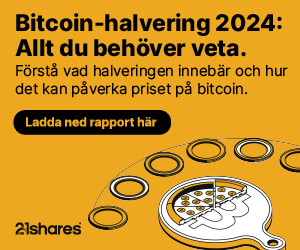Nyheter
Geopolitical Conflict on the Rise, while Ethereum Receives its Biggest Boost
Publicerad
2 veckor sedanden
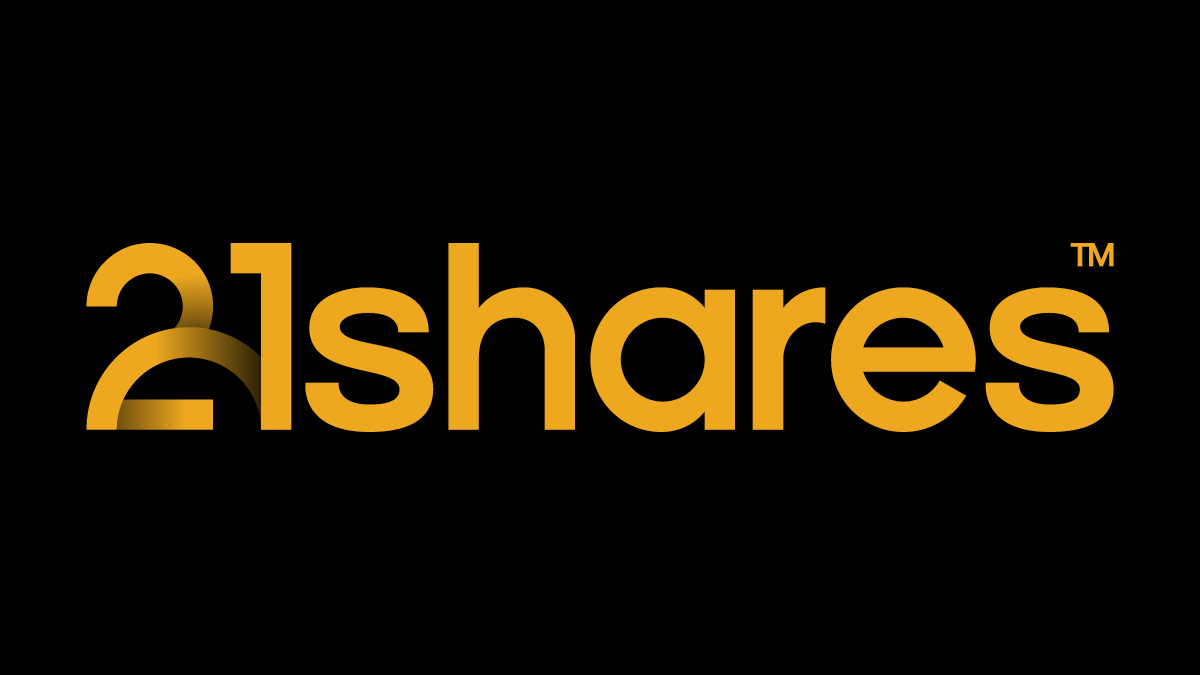
• Expanding Geopolitical Conflict Throws Crypto in Turmoil, Hong Kong ETFs Revive Hope
• Ethereum’s Most Anticipated Application of the Year is Live
Expanding Geopolitical Conflict Throws Crypto in Turmoil, Hong Kong ETFs Revive Hope
The latest Consumer Price Index (CPI) report released last Wednesday revealed a hotter-than-expected inflation rate of 3.5%, exceeding forecasts of 3.4%. This marks the fourth consecutive month where inflation has surpassed expectations, dimming hopes of rate cuts in the near future, resulting in a sustained high interest environment. This is further evidenced by interest rate futures currently pricing in just two rate cuts for the entirety of 2024, a significant shift from four months ago, when markets were predicting a more hawkish approach. Further, the conflict between Iran and Israel escalated more this weekend, as Iran launched a drone strike towards Israel, who are said to be potentially preparing for ‘retaliation’. This rise in geopolitical tensions coincided with a decline in the crypto market as Bitcoin (BTC) and Ethereum (ETH) prices fell by 8.22% and 11.29% respectively.
That said, it’s worth remembering that Bitcoin is viewed as a flight to safety during geopolitical conflicts. For instance, BTC grew by almost 17% during Russia’s invasion of Ukraine. This was driven by the fact that the average Russian citizen was able to withdraw their capital out of banks promptly before the imposed sanctions. Similarly, Ukrainians leveraged Bitcoin’s decentralized nature to navigate the overall shutdown of their financial system, while leveraging it to resume raising donations, showcasing its value as a decentralized and globally accessible asset immune to disruptions.
However, Bitcoin’s response to Iran’s recent escalation may have been adverse. This is given the gravity and the complexity of the geopolitical situation and its potential to entangle several other actors into the conflict, potentially affecting a broader swath of the world, including global trade and economic stability. Nevertheless, Bitcoin’s properties uniquely position it to serve a dual function as both a risk-on and risk-off asset. This duality could explain why its behavior diverged from that of gold in recent days, facing a drawdown last week versus benefiting from Russia’s conflict in 2022, as shown below in Figure 1.
Figure 1: BTC vs Gold Performance in 2022 vs 2024 – On a Weekly Timeframe
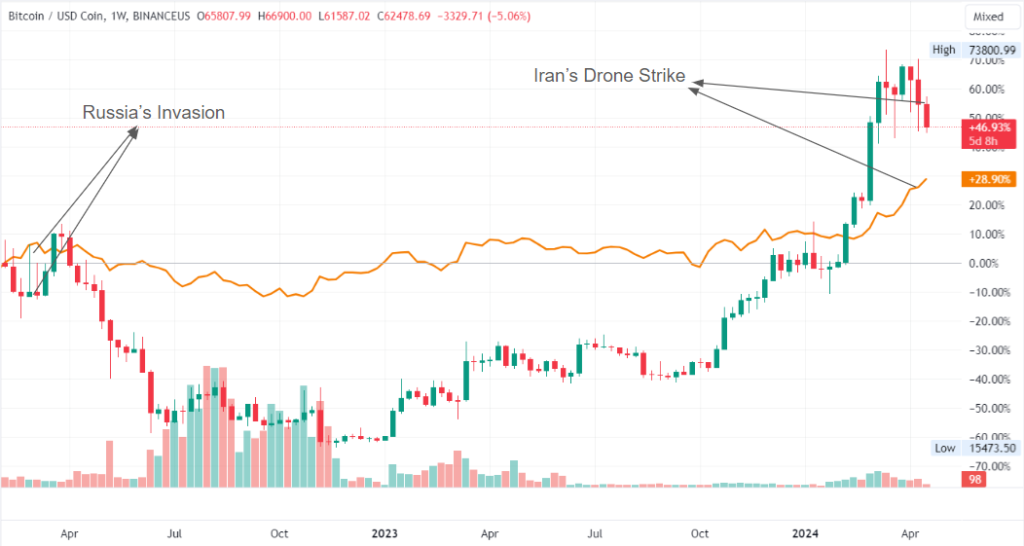
Source: TradingView
Finally, while the industry showed signs of a tentative recovery following last week’s economic challenges, evidenced by BTC soaring to nearly $67K on Monday, it’s crucial to maintain vigilance and closely monitor Israel’s response as it could have additional repercussions on the global market. Bitcoin faces a pivotal week with the highly anticipated Bitcoin Halving event scheduled in just four days, which will cut the issuance of new BTC in half, further tightening its already limited supply. This scarcity narrative is often seen as a bullish signal, which potentially bolsters Bitcoin’s position as a store of value and a hedge against inflation, as investors seek refuge in the current environment.
Adding to the positive sentiment, the Hong Kong Securities and Futures Commission (SFC) recently granted conditional approval for the launch of the first spot Bitcoin and Ethereum ETFs. The investment vehicle could unlock up to $25B in demand from Chinese investors via the Southbound Stock Connect program, according to Matrixport. The approval could also expand BTC’s market penetration into the wealth management sector in Hong Kong valued at $1.15T. The combined effect of the halving and the ETF approvals could provide a much-needed boost to the industry’s current momentum. A trend which is evident in Figure 2 below, indicating that flows into BTC have remained positive since the beginning of the year.
Figure 2 – *BTC Monthly Balance Change vs BTC Monthly Issuance vs ETF Cumulative Flows
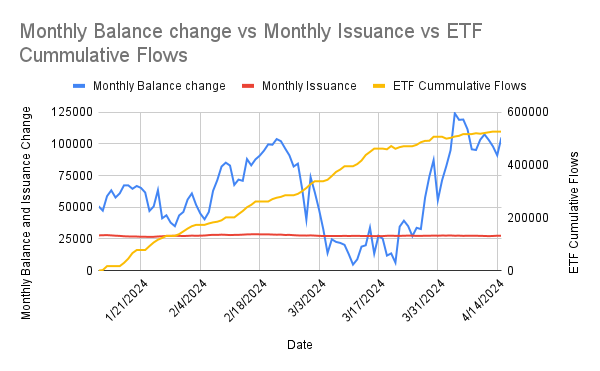
Source: Glassnode
*Monthly Balance Change includes different cohort of investors that hold >1, >10, >100, >1K BTC
Ethereum’s Most Anticipated Application of the Year is Live
EigenLayer, a protocol that allows ETH users to “re-stake” their existing staked ETH to validate the security of external networks known as Actively Validated Services (AVS), has finally deployed on mainnet. EigenLayer has been long anticipated as it enables capital efficiency by allowing users to earn additional yield on top of their ETH staking yield. Further, it allows younger protocols to borrow the security assurances of Ethereum. This is crucial, as it circumvents the need for non-established protocols to develop their own security measures from scratch. This translates to a more cost-efficient approach while simultaneously bolstering their decentralization, as newer projects can anchor their security to Ethereum’s.
By opting to earn additional yield, users subject themselves to heightened smart contract risks, as they become exposed to the vulnerabilities of both Ethereum and the additional protocol relying on its security. Further, a large portion of ETH could end up being “re-staked” in EigenLayer instead of just validating the security of Ethereum, creating a problem of misalignment. In simpler terms, some validators might focus on maximizing their profits by pursuing strategies that prioritize short-term gains over the long-term security of the network. Moreover, the growing enthusiasm for the protocol suggests that a significant portion of the crypto economy might rely on Ethereum’s security assurances. Currently, 14% of all staked ETH is being allocated towards Eigen’s re-staking strategy. The continuation of this trend could lead to centralization, posing a risk as Ethereum might inadvertently become a single point of failure over a longer time horizon.
Wide-spread slashing is another concern. In essence, if a substantial amount of ETH is restaked in a single protocol, then a slashing event due to malicious or unintended behavior could significantly impact honest ETH stakers. Thus, Eigen proposed a slashing committee, comprising esteemed ETH developers and trusted community members, empowered to veto such occurrences and safeguard Ethereum’s integrity.
The final risk concerns a new breed of tokens known as Liquid Restaking Tokens (LRTs), which operate atop EigenLayer. LRTs, akin to Liquid Staking Tokens (LSTs) issued by the established Lido protocol in 2021, aim to unlock similar capital efficiency by allowing users to use their re-staked ETH as collateral for lending and borrowing. Given that restaked ETH in Eigen can’t be used across DeFi platforms, users have turned to LRT protocols like Ether.fi and Renzo to seek higher levels of capital flexibility, with their restaked assets. For context, LRTs grew exponentially by a factor of 28 throughout Q1, increasing from nearly 100K units to the current figure of 2.8M, as can be seen below in Figure 3, showing its soaring demand.
Figure 3 – Growth of Liquid Restaking Tokens (LRTs) on EigenLayer

Source: @yulia_is_here on Dune
While LRTs can offer amplified gains through leveraged lending, they can also exacerbate losses, potentially increasing systemic risk in market downturns. Since some LRT protocols can’t offer withdrawal yet, users may be forced to swap their LRT token into ETH on thinly traded secondary markets and intensify their drawdowns.
All in all, the impact of Eigenlayer is not to be understated, as the excitement surrounding the new primitive has propelled it to become the second largest protocol on Ethereum by Total Value Locked (TVL), boasting an impressive $12.6B. This already eclipses the TVL of established players like Solana by fourfold, highlighting the immense potential and adoption that EigenLayer is witnessing despite its brief existence. Further, the excitement building up to its launch since they unveiled their roadmap in March has propelled the Ethereum validator entry queue to its highest level since September. The queue now necessitates a minimum waiting period of ~12 days before new validators can join the network, as seen below in Figure 4. Nevertheless, keep an eye out as we prepare to release a more in-depth exploration of EigenLayer risks over the coming weeks.
Figure 4: Ethereum Validator Entry Queue in Days
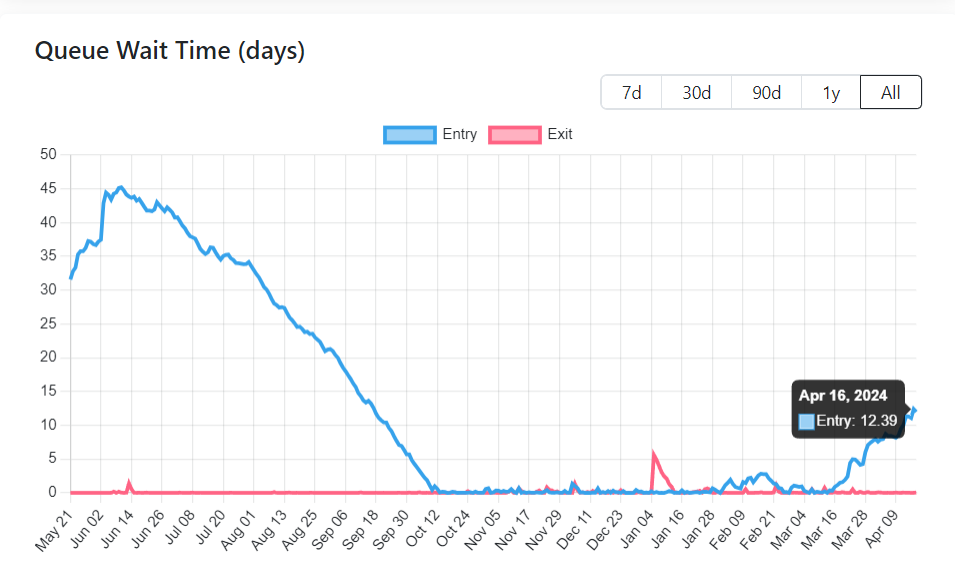
Source: ValidatorQueue
Bookmarks
Have you read our latest report, The Bitcoin Halving and Beyond? Click here to get a digital copy.
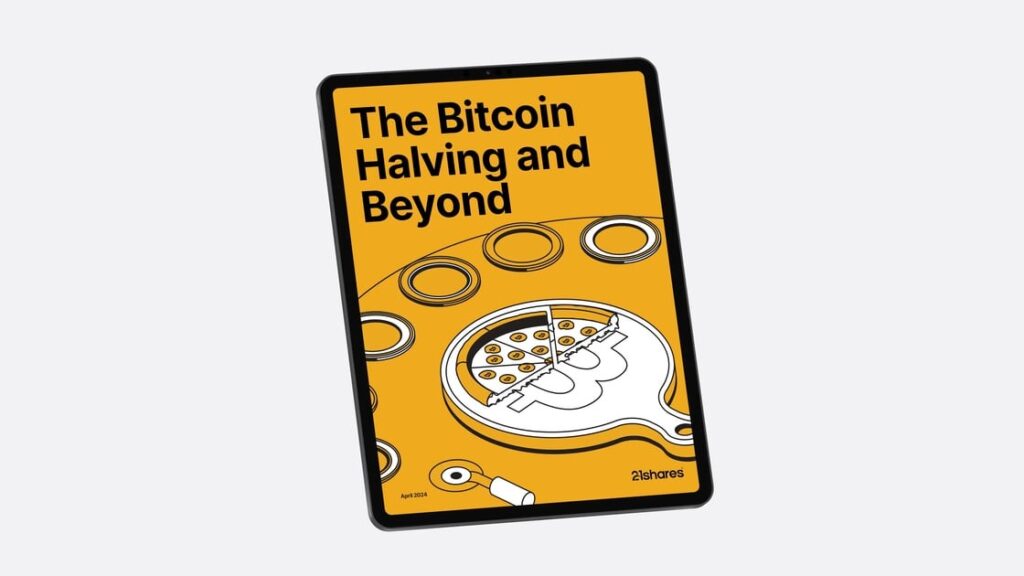
This Week’s Calendar

Source: Forex Factory, 21Shares
Research Newsletter
Each week the 21Shares Research team will publish our data-driven insights into the crypto asset world through this newsletter. Please direct any comments, questions, and words of feedback to research@21shares.com
Disclaimer
The information provided does not constitute a prospectus or other offering material and does not contain or constitute an offer to sell or a solicitation of any offer to buy securities in any jurisdiction. Some of the information published herein may contain forward-looking statements. Readers are cautioned that any such forward-looking statements are not guarantees of future performance and involve risks and uncertainties and that actual results may differ materially from those in the forward-looking statements as a result of various factors. The information contained herein may not be considered as economic, legal, tax or other advice and users are cautioned to base investment decisions or other decisions solely on the content hereof.
Du kanske gillar
-
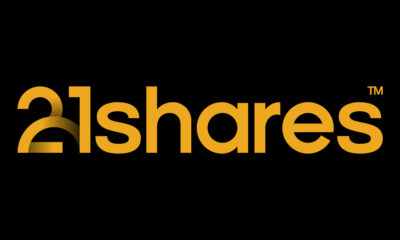

Navigating Macro Headwinds, On-Chain Optics, and The Rise of Runes
-
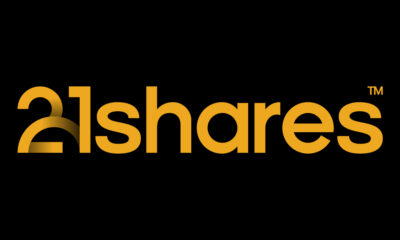

The Bitcoin Halving and Beyond
-
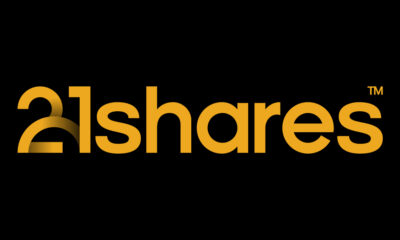

Bitcoin Shakes off FUD While Solana Gets Help
-


TONN ETP replikerar utvecklingen av Toncoins prisutveckling
-
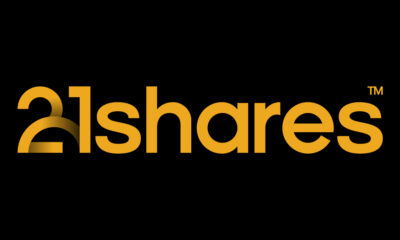

All-Time Highs, Dramatic Gas Reduction, and Tokenization
-


21Shares lanserar Toncoin Staking ETP (TONN)
Nyheter
De mest populära börshandlade fonderna april 2024
Publicerad
17 timmar sedanden
29 april, 2024
April, är nu slut, och vi har som vanligt gjort en sammanställning av de mest populära börshandlade fonderna april 2024. Dessa månadsvisa sammanställningar är ett sätt för oss att se vilka ETFer som trendar och vad våra läsare finner intressant. Vi använder sedan detta för att skriva nya artiklar på Etfmarknaden.se.
XACT Norden Högutdelande är utan tvekan den mest populära av alla de ETFer som vi har skrivit om på vår sida. Den kvartalsvisa utdelningen och dess satsning på aktier med en låg volatilitet och hög direktavkastning gör det till en populär fond som återfinns i mångas depåer. Vi har aldrig sett någon annan ETF vara med populär på vår sajt än denna börshandlade fond. Denna månad såg vi mer än 20 olika varianter av denna ETF bland de mest populära börshandlade fonderna på vår sida.
Fonder som satsar på försvarsindustrin har kommit att bli allt mer populära, något som förklaras av att Sverige gått med i NATO, men också av det geopolitiska läget i världen. En börshandlad fond som har tilldragit sig stort intresse är ASWC.
Future of Defense UCITS ETF (ASWC) noterades på Londonbörsen och Deusche Börse XETRA den 4 juli där den handlas under kortnamnet (ASWC ETF) försöker spåra EQM NATO+ Future of Defense-index. EQM NATO+ Future of Defense-index spårar resultatet för företag världen över som är engagerade i militär- eller försvarsindustrin.
ASWC, som följer EQM Future of Defense Index, strävar efter att ge exponering för de globala företag som genererar intäkter från NATO och icke-NATO (NATO+) allierade försvars- och cyberförsvarsutgifter.
Vi befinner oss för närvarande mitt i det största landkriget i Europa sedan 1945. Medan det omedelbara hotet om militär konflikt mellan Ryssland och USA är lågt, utgör Ryssland och andra stater ett allvarligt och föränderligt hot mot Amerika och dess allierade. Nato är en viktig första försvarslinje.
En annan populär försvarsfond är VanEck Defence UCITS ETF en europeiska försvarsfond som nyligen nådde förvaltad volym på 500 miljoner MUSD ett år efter lanseringen. Fonden investerar över hela världen i företag som är verksamma inom försvarsindustrin eller är involverade i försvarsrelaterade statliga kontrakt. Mot bakgrund av de nuvarande globala kriserna har synen på säkerhets- och försvarssektorn också förändrats i Europa,
Stort intresse för amerikanska large caps
Fonder som följer S&P 500 är, föga förvånande, en typ av fonder som det finns stort intresse kring. Det är ingen speciell enskild fond som sticker ut och lockar mer än andra. Det skall emellertid noteras att många sökningar sker på ord som ”Fond som följer S&P500 Avanza”.
För sju månader sedan köpte den amerikanska fondförvaltaren Ark Invest den tematiska ETF-emittenten Rize ETF från AssetCo, vilket markerar företagets första intåg på den europeiska ETF-marknaden. Efter detta har Rize ETF bytt namn till ARK Invest Europé, lagt ned större delen av alla de fonder som Rize ETF hade lanserat. Under april 2024 kom nyheten om att ARK Invest Europé lanserade tre europeiska börshandlade fonder, som är kopior av de fonder som den amerikanska förvaltaren erbjuder i USA. Detta ledde till att många som tidigare varit förhindrade att köpa denna ETF nu sökt ytterligare information om ARKs europeiska fonder.
Efter att ETFer för Bitcoin har godkänts i USA, och även Storbritannien har indikerat ett grönt ljus vänds nu fokus mot nästa kryptovaluta, Etherum. Den mest populära börshandlade produkten på vår sida är Ethereum Zero SEK en börshandlad produkt, som exakt speglar priset på Ethereum (ETH) utan avdrag för förvaltningsavgifter, vilket gör investeringar i världens näst största digitala tillgång enklare, säkrare och mer kostnadseffektivt än andra alternativ.
Produkten är en strukturerad investering i form av ett tracker certifikat enligt svensk lag. Den handlas på Nordic Growth Market (NGM) som är den primära marknadsplatsen.
ETFer med månatlig utdelning lockar
ETF med månatliga utdelningar är något som vi sett på denna lista de senaste månaderna. Det finns flera sådana tillgängliga för svenska investerare, till exempel JPM Global Equity Premium Income UCITS ETF – USD (dist) och Global X Nasdaq 100 Covered Call UCITS ETF USD Distributing (QYLE ETF), som emellertid skiljer sig mycket åt från varandra.
Många av de besökare som kommer till ETFmarknaden för att söka information om börshandlade fonder letar efter utdelande ETFer, och dessa två ETFer har något som sticker ut från andra ETFer. Det är en av de få aktier-ETFer som vi sett där utdelningen sker månadsvis.
I december 2023 lanserade J.P. Morgan Asset Management sin JPMorgan Global Equity Premium Income UCITS ETF (ticker: JEPG), en aktivt hanterad resultatorienterad ETF-strategi som syftar till att erbjuda investerare konsekventa inkomster: 7 till 9 procent årligen, betald månadsvis och uppskattningspotential med mindre volatilitet än JEPGs respektive riktmärke.
Månadsvis utdelning är en av orsakerna till att kanadensiska aktier som till exempel Boston Pizza har kommit att bli så pass populära, då de ger utdelning varje månad. Utdelning varje månad fungerar för många investerare som ett alternativ till lön när de går i tidig pension.
En annan börshandlad fond som har fokus på utdelningar är Global X SuperDividend UCITS ETF USD Distributing (UDIV ETF) som investerar i utdelningsaktier från hela världen. Utdelningarna i fonden delas ut till investerarna (halvårsvis).
Många vill handla kakao
Kakao har under det senaste året stigit med mer än 100 procent i pris. Det gör att många söker efter börshandlade produkter som ger exponering mot priset på denna råvara. Det finns emellertid ingen ren ETF som investerar i kakao i Europa. Det finns däremot börshandlade produkter, till exempel ETPer, så kallade certifikat.
WisdomTree Cocoa (COCO) är det enda rena alternativet vi har hittat. Annars finns WisdomTree Cocoa 2x Daily Leveraged (4RUP ETC) som ger den dubbla kursutvecklingen för kakaopriset, både när det stiger och faller.
Valour Ripple (XRP) SEK är en börshandlad produkt som spårar priset på XRP, Ripples infödda token. XRP förbättrar främst globala finansiella överföringar och utbyte av flera valutor. Snabb och miljövänlig, den digitala tillgången XRP designades för att fungera som den mest effektiva kryptovalutan för olika applikationer inom finanssektorn.
Valour Ripple (XRP) SEK ETP (ISIN: CH1161139584) är en börshandlad produkt som spårar priset på XRP, Ripples infödda token.
XRP har ett börsvärde på 29,57 miljarder USD och rankas på en sjätte plats bland alla kryptovalutor globalt. Ripple XRP är en nyckelspelare inom det digitala valutaområdet, känd för sin användning för att underlätta snabba och billiga internationella pengaöverföringar. XRP fungerar på RippleNet och fungerar som en bryggvaluta i Ripples betalningsnätverk, vilket möjliggör sömlösa valutaväxlingar över hela världen. Detta har positionerat XRP som ett föredraget val för finansiella institutioner som söker effektiva alternativ till traditionella gränsöverskridande betalningsmetoder.
En annan populär ETFen är XACT Sverige, som även denna lämnar utdelning. Till skillnad från XACT Norden Högutdelande sker utdelningen endast en gång per år. Denna ETF meddelade att den fastställt utdelningen för 2024 under februari månad.
I februari 2024 lanserades Valour Binance (BNB) SEK, en börshandlad produkt som spårar priset på kryptovalutan BNB, den inhemska kryptovalutan som utfärdas av Binance-börsen och körs på Binance-kedjan. Den kan användas för betalningar på transaktionsavgifter (på Binance-kedjan), resebokningar, underhållning, onlinetjänster och andra finansiella tjänster. Valour Binance (BNB) gör investeringar i detta ekosystem enkel, säker och kostnadseffektiv, tillgänglig för köp på reglerade börser via vilken bank eller mäklare som helst.
BNB kan användas för att betala avgifter vid handel på Binance, och vanligtvis till en rabatterad kurs. På grund av den primära nyttan har BNB sett en betydande tillväxt i intresse genom åren. Flera omgångar av token burn-händelser har uppskattat BNB-priset och drivit det upp som en av de fem bästa kryptovalutorna efter börsvärde.
Är det dags att titta på fastighetsbolagen igen?
Ett relativt nytt begrepp på listan är ETF fastigheter. Allt fler investerare tror att vi kommer att få se räntesänkningar i år, inte bara i Sverige och Europa, men även i USA. Lägre räntor gör det enklare att räkna hem en investering i fastigheter. Kan det vara så att våra besökare undersöker möjligheterna att positionera sig i en ETF för fastigheter innan räntorna sänks för att de tror att det kommer att leda till en uppvärdering av fastighetsbolagen?
Valour SOLANA (SOL) är en börshandlad produkt, som gör investeringar i SOL enkla, säkra och kostnadseffektiva. Solana är en decentraliserad blockchain och den snabbaste blockchain i världen, med mer än 400 projekt som spänner över DeFi, NFT, Web3 och mer.
Produkten är en en strukturerad investering i form av ett tracker certifikat enligt svensk lag. Den handlas på Nordic Growth Market (NGM) som är den primära marknadsplatsen.
Swedbank ETF tror vi kan tolkas att det endera finns intresse för att veta om Swedbank har ETFer i sitt utbud, eller om det går att handla börshandlade fonder på Swedbank. Svaret på denna fråga återfinns här.
Tidigare var det många som sökte på begreppet ESG, men detta sökord har fallit från listan under de senaste månaderna. En variant av ESG-fond är de fonder som har en islamistisk inriktning, så kallade halalfonder., och det är fortfarande något som våra besökare letar information om. En sådan fond är ASWE, som är en aktivt förvaltad shariafond men till exempel HSBC har en serie fonder med fokus på att investera enligt islam. Det är ingen speciell enskild fond som sticker ut och lockar mer än andra.
Utöver Valour finns det flera andra emittenter av börshandlade kryptovalutor. Faktum är att det finns en svensk sådan, Virtune. Detta företag kommer inte bland de högsta när våra läsare söker på vår sida, men när det söks är det tydligen kunder hos Avanza som söker. Vi ser många sökningar på Virtune Bitcoin Avanza. Vi ser märkligt nog ännu flera sökningar på Henry Forelius som arbetar på Virtune. Av någon anledning söker fler besökare på honom än på Virtune. Denna emittent skulle återkomma till oss efter jul, så vi hoppas att det kan bli mer artiklar om deras produkter i framtiden.
Valour Cardano (ADA) SEK är inte bara en Cardano ETP, det är också den första att handlas på en nordisk börs. Det betyder att det går att handla andelar i denna ETF genom de flesta svenska banker och Internetmäklare, till exempel DEGIRO, Nordnet, Aktieinvest och Avanza.
VGWD ETF, eller VGWD Vanguard FTSE All-World High Dividend Yield UCITS ETF Distributing som är dess fullständiga namn, handlas bland annat på tyska Xetra, vilket gör att det går att handla den direkt genom DEGIRO, Nordnet, Aktieinvest och Avanza. VGWD ger bred exponering mot de största företagen med högre avkastning på utvecklade och tillväxtmarknader, men utesluter fastighetsbolag. Som alla andra av Vanguards ETFer så har den en låg förvaltningsavgift, 0,29 procent. Den kan liknas vid en global variant av XACT Norden Högutdelande eftersom den investerar i högavkastande aktier från hela världen.
Även Nasdaq-spårande fonder lockar sparare
Fond som följer Nasdaq-100 är ett annat relativ nytt begrepp på denna lista. Det är däremot inte konceptet, i princip varje större emittent på marknaden erbjuder minst en sådan ETF. Invesco som i USA har den populära fonden QQQ, erbjuder flera olika alternativ på den europeiska marknaden.
HBAR är en börshandlad produkt som inte ens har hunnit lanseras ännu. I slutet av januari kommunicerade Valour att företaget hade för avsikt att lansera en fysiskt uppbackad börshandlad produkt (ETP) Valour HBAR Staking ETP i samarbete med The Hashgraph Association (THA) – en schweiziskbaserad produkt oberoende och ideell organisation fokuserad på att ge en digital framtid för alla genom att utnyttja Hederas miljövänliga distribuerade ledger-teknologi (DLT).
Lanseringen har ännu inte skett, men vi är övertygade om att vi ser denna inom kort. Om den kommer att handlas under kortnamnet HBAR är ännu inte kommunicerat.
ETF Indien är inte en specifik börshandlad fond, men förekommer i en mängd olika varianter. Det finns tydligen ett stort intresse för att investera i indiska aktier bland sidan besökare, och då är kanske en ETF ett bra sätt att göra det. Vi skrev under i början av året en artikel om olika Indienfonder.
Stigande guldpris
I och med att guldpriset har rört sig uppåt har intresset för guldfonder kommit att bli mer populärt överlag. Den mest populära fonden är 4GLD, Xetra-Gold som erbjuder investerare en optimal och enkel möjlighet att delta i utvecklingen av guldmarknaden. Dessutom är handel med Xetra-Gold också mycket kostnadseffektiv eftersom den till skillnad från andra värdepapper inte kommer med varken abonnemangsavgifter eller förvaltningsavgifter.
Under januari 2024 gav den amerikanska finansinspektionen SEC tillstånd för de första amerikanska Bitcoin ETFerna. Detta i samband med att priset på denna kryptovaluta har stigit till nivåer som Bitcoin inte handlats till på flera år, en effekt av just de nya börshandlade fonderna, har gjort att vi sett ett mycket stort intresse för detta på sidan. Många söker på just Bitcoin ETF, något som inte är tillåtet i Europa, på grund av att en ETF måste ha mer än en underliggande tillgång. Istället kallas dessa produkter för ETP eller ETC, och skillnaden är relativt liten. Vi skrev för ett par veckor sedan en artikel som i kallade för Vilken Bitcoinprodukt är bäst? i syfte att titta närmare på alla de fonder, certifikat och produkter som spårar Bitcoin.
Många söker information om fonder som investerar i halvledare
Många besökare har letat efter information om halvledarfonder, vilket vi tagit fasta på. Denna månad har vi publicerat texter om flera olika ETFer som investerar i halvledarföretag, och under maj kommer en artikel som samlar i hop alla dessa fonder i samma artikel.
VanEck Vectors Semiconductor UCITS ETF (VVSM ETF) som investerar i det övergripande resultatet för företag som är involverade i halvledarproduktion och utrustning.
VanEck Vectors Semiconductor UCITS ETF (VVSM ETF) är en europeisk börshandlad fond. Denna fond handlas på flera olika börser, till exempel Borsa Italiana, Deutsche Boerse Xetra och London Stock Exchange. Av den anledningen förekommer olika kortnamn på samma börshandlade fond.
Från och med den 14 februari 2024 kan för första gången en Exchange Traded Note (ETN) på Internet Computer (ICP), en ICP ETN, handlas via Xetra och handelsplatsen Börse Frankfurt. Utgivaren av denna ETN är Valour Digital Securities.
Med 1Valour Internet Computer Physical Staking (1VIC) kan investerare på Xetra delta i utvecklingen för Internet Computers kryptovaluta i kombination med insats för första gången utan att behöva sätta upp kryptoplånböcker. Staking är processen att deponera respektive kryptotillgångar på blockkedjan för att validera transaktioner. I gengäld betalas en premie. På detta sätt kan investerare delta inte bara i prestanda för kryptovalutan, utan också i respektive insatsinkomst.
Utdelningsfonder lockar, men en som fallit i intresse är Global X SuperDividend UCITS ETF USD Distributing (UDIV ETF) som investerar i utdelningsaktier från hela världen. Utdelningarna i fonden delas ut till investerarna (halvårsvis).
Nyheter
INQQ ETF ger exponering mot Internet och e-commerce i Indien
Publicerad
18 timmar sedanden
29 april, 2024
HANetf INQQ India Internet & Ecommerce ESG-S UCITS ETF (INQQ ETF) med ISIN IE000WYTQSF9, strävar efter att spåra INQQ The India Internet & Ecommerce ESG Screened index. INQQ The India Internet & Ecommerce ESG Screened index spårar indiska företag från sektorerna internet och e-handel. Aktierna som ingår filtreras enligt ESG-kriterier (miljö, social och bolagsstyrning).
Den börshandlade fondens TER (total cost ratio) uppgår till 0,86 procent p.a. HANetf INQQ India Internet & Ecommerce ESG-S UCITS ETF är den enda ETF som följer INQQ The India Internet & Ecommerce ESG Screened index. ETFen replikerar det underliggande indexets prestanda genom full replikering (köper alla indexbeståndsdelar). Utdelningarna i ETFen ackumuleras och återinvesteras.
Denna börshandlade fond lanserades den 15 november 2023 och har sin hemvist i Irland.
Fondöversikt
INQQ India Internet & Ecommerce ESG-S UCITS ETF ger investerare en riktad exponering mot den indiska internet- och e-handelssektorn.
Indien är nu världens folkrikaste land, Indien har blivit en av de snabbast växande stora ekonomierna. Centralt för denna tillväxt har varit medelklassens expansion, vilket har gjort det möjligt för delar av befolkningen att få tillgång till internet och ökat onlinekonsumtionen.
Samtidigt har Indien snabbt utökat sin digitala infrastruktur, vilket möjliggör oöverträffade nivåer av anslutning. Dessa faktorer har fått analytiker att tro att landet går in i en digital guldålder. Innehav i Indien ETF kontrolleras för att säkerställa att majoriteten av deras intäkter kommer från internet- och e-handelsaktiviteter i Indien.
India ETF spårar INQQ The India Internet & Ecommerce ESG Screened Index och använder en ESG-screening.
Varför INQQ India ETF
Snabb digitalisering av Indien: Indien är den snabbast växande stora ekonomin och har blivit det folkrikaste landet i världen. Med cirka 7 miljoner nya smartphoneanvändare varje månad kommer delar av befolkningen online i en aldrig tidigare skådad hastighet – men data tyder på att vi fortfarande är tidigt ute när det gäller smartphonepenetration.
Rent exponering mot Indien: Bredare Indiens index kan drabbas av problem som att inkludera statligt ägda företag, överviktning av äldre bank- och oljesektorer och företag ”förklädda” till indiska som genererar det mesta av sin verksamhet i Europa eller USA. INQQ strävar efter att uppnå ren exponering för Indien genom omfattande screening.
ESG-screenad exponering: Unik möjlighet att få tillgång till den snabba tillväxten av den indiska internet- och e-handelsekonomin via en ESG-skärm. Aktier som inte uppfyller de strikta kriterierna exkluderas från indexet.
Handla INQQ ETF
INQQ India Internet & Ecommerce ESG-S UCITS ETF (INQQ) är en europeisk börshandlad fond. Denna fond handlas på flera olika börser, till exempel Deutsche Boerse Xetra och London Stock Exchange.
Det betyder att det går att handla andelar i denna ETF genom de flesta svenska banker och Internetmäklare, till exempel DEGIRO, Nordnet, Aktieinvest och Avanza.
Största innehav
| Värdepapper | Vikt % |
| ZOMATO LTD | 9.91% |
| RELIANCE INDUSTRIES LTD | 6.47% |
| BAJAJ FINANCE LTD | 6.33% |
| INFO EDGE (INDIA) LIMITED | 6.31% |
| MAKEMYTRIP LTD | 6.20% |
| FRESHWORKS INC-CL A | 5.55% |
| INDIAN RAILWAY CATERING & TO | 5.52% |
| FSN E-COMMERCE VENTURES LTD | 5.16% |
| PB FINTECH LTD | 5.09% |
| ONE 97 COMMUNICATIONS LTD | 4.94% |
Innehav kan komma att förändras

Nasdaq 100-indexet följer de 100 största aktierna noterade på Nasdaq-börsen. De utvalda företagen kommer huvudsakligen från sektorer som hårdvara och mjukvara, telekommunikation, detaljhandel och bioteknik – inklusive alla stora amerikanska teknikföretag. Däremot ingår inte företag från energi-, finans- och fastighetssektorerna i Nasdaq-100. Vilken är den bästa fond som följer Nasdaq-100?
I USA har den populära QQQ ETF, som spårar Nasdaq 100, varit tillgänglig sedan 1999. Den förvaltas av Invesco. Den europeiska motsvarigheten till denna ETF använder tickersymbolen eQQQ. Till skillnad från den amerikanska marknaden finns det dock flera ETF-leverantörer i Europa som spårar Nasdaq 100 – så det är värt att jämföra.
ETF-investerare kan dra nytta av värdeökningar och utdelningar från Nasdaq 100-beståndsdelarna. För närvarande spåras Nasdaq 100-indexet av tretton ETFer.
Förvaltningsarvode fond som följer Nasdaq-100
Nedan har vi listat förvaltningsarvoden för fond som följer Nasdaq-100. Samtliga dessa ETFer har en konkurrenskraftig prissättning, allt från AXA IM Nasdaq 100 UCITS ETF USD Acc, som debiterar sina andelsägare 0,14 procent per år till iShares Nasdaq 100 UCITS ETF (Acc) som tar ut 0,33 procent i arvode. I jämförelse kostar de flesta aktivt förvaltade fonder mycket mer avgifter per år.
| Namn | Valuta | ISIN | Kortnamn | Förvaltningsavgift |
| AXA IM Nasdaq 100 UCITS ETF USD Acc | USD | IE000QDFFK00 | ANAU | 0.14% |
| Invesco Nasdaq-100 Swap UCITS ETF Acc | USD | IE00BNRQM384 | EQQX | 0.20% |
| Invesco Nasdaq-100 Swap UCITS ETF Dist | USD | IE000RUF4QN8 | EQQD | 0.20% p.a. |
| Xtrackers Nasdaq 100 UCITS ETF 1C | USD | IE00BMFKG444 | XNAS | 0.20% |
| Amundi Nasdaq-100 II UCITS ETF Acc | EUR | LU1829221024 | LYMS | 0.22% |
| Amundi Nasdaq-100 II UCITS ETF Dist | USD | LU2197908721 | NADQ | 0.22% |
| Amundi Nasdaq 100 UCITS ETF EUR (C) | EUR | LU1681038243 | 6AQQ | 0.23% |
| Amundi Nasdaq 100 UCITS ETF USD | USD | LU1681038326 | 10A4 | 0.23% |
| Deka Nasdaq-100® UCITS ETF | EUR | DE000ETFL623 | D6RH | 0.25% |
| Invesco EQQQ Nasdaq-100 UCITS ETF | USD | IE0032077012 | EQQQ | 0.30% |
| Invesco EQQQ Nasdaq-100 UCITS ETF Acc | USD | IE00BFZXGZ54 | EQQB | 0.30% |
| iShares Nasdaq 100 UCITS ETF (DE) | USD | DE000A0F5UF5 | EXXT | 0.31% |
| iShares Nasdaq 100 UCITS ETF (Acc) | USD | IE00B53SZB19 | SXRV | 0.33% |
Som alltid vill vi påminna att om det finns flera olika börshandlade fonder som täcker samma index eller segment är det förvaltningskostnaden som avgör. Antar vi att dessa Nasdaqfonder ger samma avkastning kommer den som har lägst avgift att utvecklas bäst, allt annat lika. Grundregeln är alltså, betala aldrig för mycket då detta kommer att äta upp din avkastning.
Nasdaq 100 ETFer i jämförelse
Förutom avkastning finns det ytterligare viktiga faktorer att tänka på när du väljer en Nasdaq 100 ETF. För att ge ett bra beslutsunderlag hittar du en lista över alla Nasdaq 100 ETFer med detaljer om vinstanvändning, fondens hemvist och replikeringsmetod.
| Namn | Utdelningspolicy | Hemvist | Replikeringsmetod |
| iShares Nasdaq 100 UCITS ETF (Acc) | Ackumulerande | Irland | Fysisk replikering |
| Invesco EQQQ Nasdaq-100 UCITS ETF | Utdelande | Irland | Fysisk replikering |
| iShares Nasdaq 100 UCITS ETF (DE) | Utdelande | Tyskland | Fysisk replikering |
| Amundi Nasdaq-100 II UCITS ETF Acc | Ackumulerande | Luxemburg | Ofinansierad swap |
| Invesco EQQQ Nasdaq-100 UCITS ETF Acc | Ackumulerande | Irland | Fysisk replikering |
| Amundi Nasdaq 100 UCITS ETF EUR (C) | Ackumulerande | Luxemburg | Ofinansierad swap |
| Amundi Nasdaq-100 II UCITS ETF Dist | Utdelande | Luxemburg | Ofinansierad swap |
| AXA IM Nasdaq 100 UCITS ETF USD Acc | Ackumulerande | Irland | Fysisk replikering |
| Xtrackers Nasdaq 100 UCITS ETF 1C | Ackumulerande | Irland | Fysisk replikering |
| Invesco Nasdaq-100 Swap UCITS ETF Acc | Ackumulerande | Irland | Ofinansierad swap |
| Amundi Nasdaq 100 UCITS ETF USD | Ackumulerande | Luxemburg | Ofinansierad swap |
| Invesco Nasdaq-100 Swap UCITS ETF Dist | Utdelande | Irland | Ofinansierad swap |
| Deka Nasdaq-100® UCITS ETF | Utdelande | Tyskland | Fysisk replikering |
Handla fond som följer Nasdaq-100
Samtliga dessa ETFer är europeiska börshandlade fonder. Dessa fond handlas på flera olika börser, till exempel Deutsche Boerse Xetra och London Stock Exchange.
Det betyder att det går att handla andelar i denna ETF genom de flesta svenska banker och Internetmäklare, till exempel DEGIRO, Nordnet, Aktieinvest och Avanza.

De mest populära börshandlade fonderna april 2024

INQQ ETF ger exponering mot Internet och e-commerce i Indien

Vilken är den bästa fond som följer Nasdaq-100?

Inevitable in India: Crowds, cricket and capital gains tax

XB33 ETF köper företagsobligationer i euro som förfaller 2033

ETFmarknaden i Europa firar sitt 24-årsjubileum med tillgångar på två biljoner USD

De mest populära börshandlade fonderna mars 2024

Tillgång till obligationsmarknaden för företagsobligationer från utvecklade marknader

FUIG ETF investerar i hållbara företagsobligationer som följer Parisavtalet

Försvarsfond når förvaltad volym på 500 MUSD
Populära
-

 Nyheter2 veckor sedan
Nyheter2 veckor sedanETFmarknaden i Europa firar sitt 24-årsjubileum med tillgångar på två biljoner USD
-

 Nyheter4 veckor sedan
Nyheter4 veckor sedanDe mest populära börshandlade fonderna mars 2024
-

 Nyheter2 veckor sedan
Nyheter2 veckor sedanTillgång till obligationsmarknaden för företagsobligationer från utvecklade marknader
-

 Nyheter4 veckor sedan
Nyheter4 veckor sedanFUIG ETF investerar i hållbara företagsobligationer som följer Parisavtalet
-

 Nyheter3 veckor sedan
Nyheter3 veckor sedanFörsvarsfond når förvaltad volym på 500 MUSD
-

 Nyheter2 dagar sedan
Nyheter2 dagar sedanVilken är den bästa fond som följer Nasdaq-100?
-
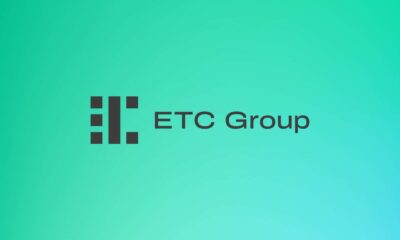
 Nyheter4 veckor sedan
Nyheter4 veckor sedanVad händer härnäst för Bitcoin?
-

 Nyheter3 veckor sedan
Nyheter3 veckor sedanNy börshandlad fond från Deka ger tillgång till S&P 500-index


